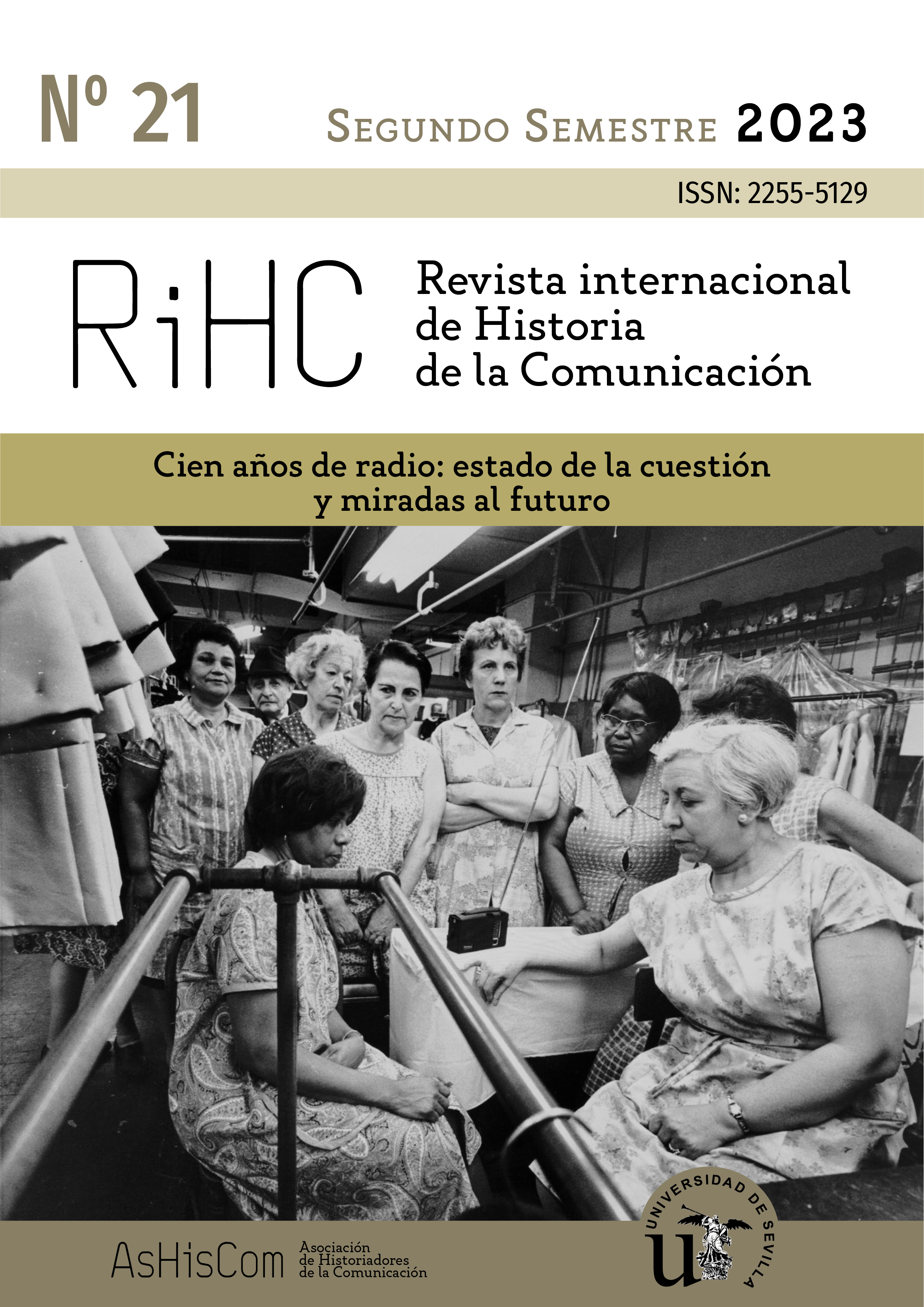Un espacio de fantasía. La publicidad radiofónica en las emisiones femeninas de Radio Madrid
DOI:
https://doi.org/10.12795/RIHC.2023.i21.03Palabras clave:
Radio, franquismo, publicidad, historia de las mujeres, historia de géneroResumen
La victoria de Franco en el conflicto armado instigó a los empresarios españoles a cimentar la unión entre publicidad y nacionalismo para mostrar su afección al régimen en el difícil periodo de postguerra. De tal modo que esta se convirtió en una parte más del entramado político de la dictadura. En este sentido, las marcas que financiaron los programas de la emisora Radio Madrid, en concreto a los femeninos, no establecieron simplemente una relación material con la audiencia, sino que construyeron un engranaje discursivo encaminado a reforzar el modelo normativo de feminidad franquista. Por tanto, la publicidad, que se valió de la eficacia comunicativa de la radio, engendró un conjunto de símbolos, creencias, asunciones, representaciones y hábitos, para crear una fantasía funcionalista. Esta se convirtió en una tecnología de género que pretendió guiar las pautas consumistas de las mujeres españolas y con ello, conectar sus prácticas sociales con las lógicas políticas e ideológicas del régimen. Para profundizar sobre estas funciones, tomaremos como fuente primaria los guiones radiofónicos de las emisiones femeninas de Radio Madrid.
Descargas
Citas
ALONSO, L. E. y CONDE, F. (1994): Historia del consumo en España: una aproximación a sus orígenes y primer desarrollo, Madrid, Debate.
ARCO BLANCO, M. A. DEL (2009): “El secreto del consenso en el Régimen franquista: cultura de la victoria, represión y hambre” en Ayer, nº 76 (4), 2009, pp. 245-268.
ANG, I. (1996): Living room wars, London and New York, Routledge.
BALSEBRE, A. (2002): Historia de la radio en España, vol. II (1939-1985), Madrid, Cátedra.
BARCIELA LÓPEZ C. et alii (2001): La España de Franco (1939-1975): Economía, Madrid, Síntesis.
BAUDRILLARD, J. (1969): El sistema de los objetos, México, Siglo XXI.
— (2009): La sociedad de consumo. Sus mitos, sus estructuras, Madrid, Sigloveintiuno de España Editores.
BRANCIFORTE, L. (2018): Donne in onda nel ventennio fascista. Tra modernitá e tradizione (1924-1939), Soveria Mannelli, Rubbettino.
CARO ALMELA, A. (2007): “Jean Baudrillard y la publicidad” en Pensar la publicidad, nº 1 (2), 2007, pp. 131-146.
CASAS SANTASUSANA, E. (1954): Cómo se vende por anuncio, Barcelona, Juan Bruguer.
CHAPMAN, T. (2004): Gender and domestic life: changing practices in families households, Houndhills, Palgrave Macmillan.
CHECA GODOY, A. (2000): Historia de la radio en Andalucía, 1917-1978, Málaga, Fundación Unicaja.
— (2007): Historia de la publicidad, Sevilla, Netbiblo.
CONDE, F. (1994): “Notas sobre la génesis de la Sociedad de Consumo en España”, en Política y sociedad, nº 16, 1994, pp. 135-148.
DYER. G. (1990): Advertising as communication, London, Routledge.
FRIEDAN, B. (1974): La mística de la feminidad, Madrid, Júcar.
GIL GASCÓN, F. Y GÓMEZ GARCÍA, S. (2010): “Al oído de las mujeres españolas. Las emisiones femeninas de Radio Nacional de España durante el primer franquismo (1937-1959)” en Estudios sobre el Mensaje Periodístico, nº 16, 2010, pp. 131-143.
GONZÁLEZ, M. J. (1979): La economía política del franquismo (1940-1970). Dirigismo, mercado y planificación, Madrid, Tecnos.
GONZÁLEZ MARTÍN, J. A. (1996): Teoría general de la publicidad, Madrid, Fondo de Cultura Económica.
HALL, S. (editor) (1997): Representation. Cultural representations and signifyng practices, London, SAGE Publications.
HARTMANN, H. (1981): “The family as the locus of gender, class and political struggle: The example of housework” en Signs: Journal of Women in Culture and Society, nº 6 (3), 1981, pp. 366-394.
HAYDEN, D. (1976): Redesigning the american dream: the future of housing, work and family life, New York-London, Norton & Company.
— (1981): The grand domestic revolution: a history of feminist designs for american homes, neighborhoods and cities, Cambridge-London, MIT press.
MARCHAND, R. (1985): Advertising the american dream: making way for modernity, 1920–1940, Berkeley, University of California.
MARTÍNEZ GALLEGO, F. y LAGUNA PLATERO, A. (2023): “Who? Para un protagonismo del sujeto en la historia de la comunicación” en Revista Internacional de Historia de la Comunicación, nº 20, 2023, pp. 80-97. https://dx.doi.org/10.12795/RIHC.2023.i20.06
MATA, Mª. C. (1999): “De la cultura masiva a la cultura mediática” en Diálogos de la Comunicación, nº 56, 1999, pp. 80-90.
MATÉS BARCO, J. M. (2006): “La economía durante el franquismo: la década de la transición (1939-1959)”, en GONZÁLEZ, A. y MATÉS, J. M. (coordinadores.), Historia económica de España, Barcelona, Ariel, pp. 707-744.
MONTERO, M. (2012): “La publicidad española durante el franquismo (1939-1975). De la autarquía al consumo” en Hispania, nº 240, 2012, pp. 205-232.
MORENO FERNÁNDEZ Mª. A. (2004): Crítica de la publicidad y su discurso. Fundamentos de la crítica de la comunicación publicitaria desde la línea de la eficacia a la publicidad como cultura, Salamanca, Librería Cervantes.
PÉREZ, I. (2012): El hogar tecnificado. Familias, género y vida cotidiana, 1940-1970, Buenos Aires, Editorial Biblos.
REDDY, W. (2001): The Navigation of Feeling: A Framework for the History of Emotions, Cambridge, Cambridge University Press.
ROMO PARRA, C. (2017): El extraño viaje del progreso. Discursos de la cotidianeidad e identidades femeninas durante el desarrollismo franquista, Sevilla, Athenaica Ediciones Universitarias.
RODRÍGUEZ MATEOS, A. (2015): “La función de la publicidad televisiva en la consolidación de la sociedad de consumo en España durante el Régimen de Franco (1956–1975)” en Journal of Spanish Cultural Studies, nº 16 (3), 2015, pp. 255-273.
ROSENWEIN, B. (2006): Emotional Communities in the Early Middle Ages, New York, Ithaca.
SCHEER, M. (2012): “Are emotions a kind of practice (and is that what makes them have a history)? A bourdieuian approach to understanding emotion” en History and Theory, nº 51, 2012, pp. 193-220.
SEBASTIÁN MORILLAS, A. (2017): “El papel de la publicidad en España en prensa y radio durante el franquismo: el nacimiento de la sociedad de consumo” en Cuadernos.info, nº 41, 2017, pp. 209-226.
SIMPSON, P. (2001): “«Reason» and «tickle» as pragmatic constructs in the discourse of advertising” en Journal of Pragmatics, nº 33, 2001, pp. 589-607.
SINCLAIR, J. (1989): Images incorporated: advertising as industry and ideology, London, Routledge.
SUEIRO SEOANE, S. (2009): “La configuración del nuevo Estado franquista en las imágenes publicitarias” en Espacio, Tiempo y Forma, Serie V, Historia Contemporánea, nº 21, 2009, pp. 171-183.
TUSELL, J. (2005): “Cinco momentos de la modernización española”, en Nestlé en España, 1905-2005. Reflexiones sobre su contribución al desarrollo económico y social, Esplugues de Llobregat, Nestlé España S.A.
WILLIAMS, R. (2004): “El sistema mágico” en Telo: Cuadernos de Comunicación e Innovación, nº 61, 2004, pp. 95-103.
WOLF, M. y BIERNATZKI, W. E. (1994): “The social and cultural effects of advertising” en Communication Research Trends, nº 14, 1994, pp. 1–2.
Descargas
Publicado
Cómo citar
Número
Sección
Licencia
Derechos de autor 2023 RIHC. Revista Internacional de Historia de la Comunicación

Esta obra está bajo una licencia internacional Creative Commons Atribución-NoComercial-CompartirIgual 4.0.
RiHC. Revista internacional de Historia de la Comunicación es una publicación de acceso libre, ofrece su contenido bajo el principio de que hacer disponible gratuitamente la investigación al publico apoya a un mayor intercambio de conocimiento global.
RIHC. Revista internacional de Historia de la Comunicación se adhiere a las diferentes iniciativas que promueven el acceso libre al conocimiento, por lo que todos los contenidos son de acceso libre y gratuito y se publican bajo licencia de Creative Commons Reconocimiento-NoComercial 4.0 Internacional.

En virtud de ello, los autores que publiquen en esta revista aceptan las siguientes condiciones:
Los autores conservan los derechos de autor y ceden a la revista el derecho de la primera publicación, con el trabajo registrado con la licencia de atribución de Creative Commons, que permite a terceros utilizar lo publicado siempre que mencionen la autoría del trabajo y a la primera publicación en esta revista.
Los autores pueden realizar otros acuerdos contractuales independientes y adicionales para la distribución no exclusiva de la versión del artículo publicado en esta revista (p. ej., incluirlo en un repositorio institucional o publicarlo en un libro) siempre que indiquen claramente que el trabajo se publicó por primera vez en esta revista.
Se permite y recomienda a los autores publicar su trabajo en Internet (por ejemplo en páginas institucionales o personales) ya que puede conducir a intercambios productivos y a una mayor y más rápida difusión del trabajo publicado (vea The Effect of Open Access).
No prevé moving wall o período de embargo
Debe utilizarse la versión de editor/PDF
La fuente editorial debe reconocerse



